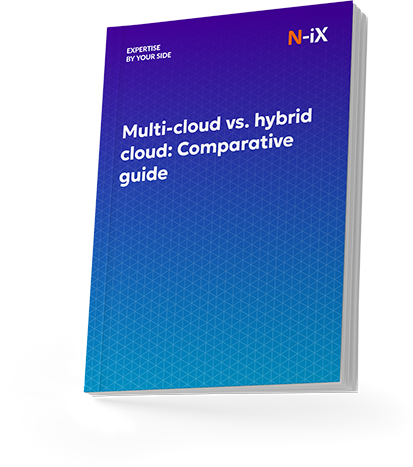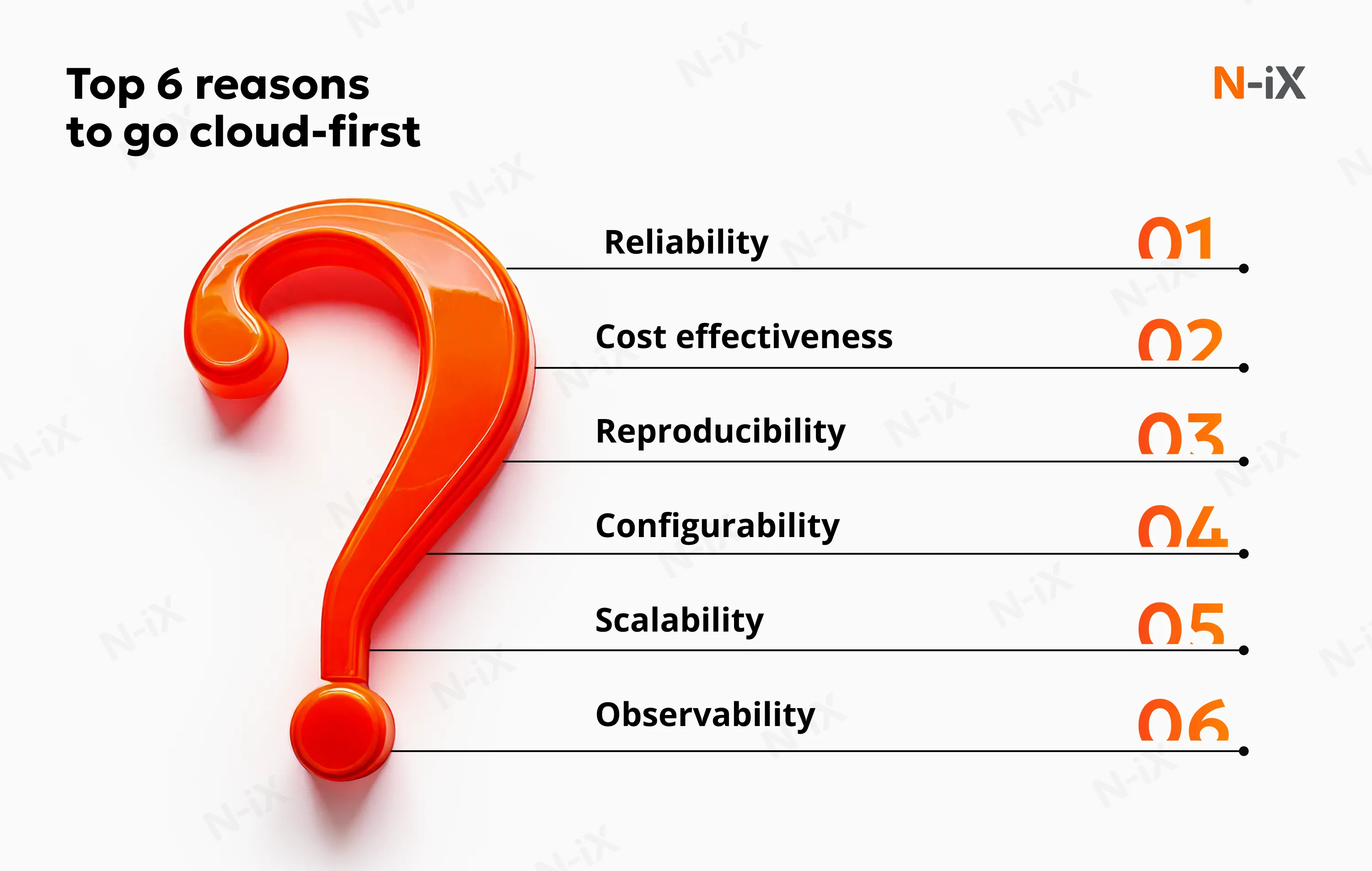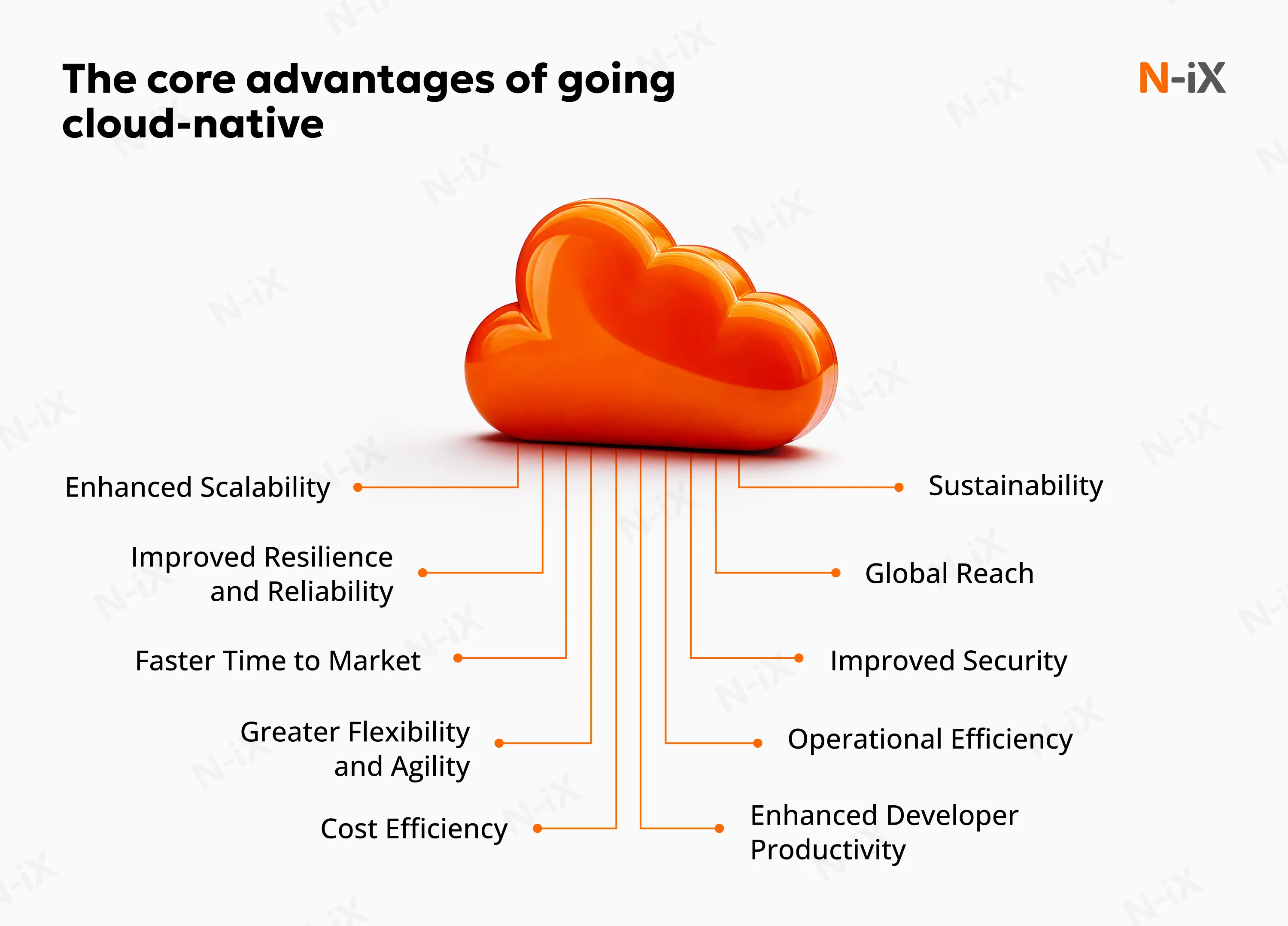The shift to cloud computing has opened multiple paths for modernizing IT infrastructure and accelerating innovation. Among the most widely adopted strategies are cloud-first and cloud-native, each offering distinct advantages depending on business goals, legacy systems you have in place, and technical readiness.
While both approaches aim to harness the power of the cloud, they differ significantly in execution, complexity, and long-term value.
So, how to design the right strategy for your organization? We asked our cloud experts to highlight the key characteristics and differences of cloud-first vs cloud-native strategies to help you make an informed decision.
What is cloud-first?
A cloud-first approach is a strategic mindset prioritizing the cloud as the primary option for deploying new applications, infrastructure, and services. This adoption strategy allows businesses to modernize gradually while maintaining legacy systems. This is especially important when legacy systems require significant refactoring to move to the cloud.
Migration efforts under a cloud-first model can take different forms, from straightforward lift-and-shift transitions to more advanced modernization efforts, depending on the complexity of IT environments and business priorities. This approach emphasizes flexibility, allowing companies to adopt cloud services in a way that best supports their goals. It also often involves hybrid or multi-cloud setups, where workloads are distributed across different environments to balance compliance, performance, and cost.
Multi-cloud vs. hybrid cloud—discover which strategy is right for your business!


Success!

Benefits of cloud-first
Organizations choose a cloud-first strategy to leverage the following benefits:
- Rapid scalability: Organizations can quickly scale resources based on demand by prioritizing cloud deployment, avoiding delays in provisioning physical hardware.
- Cost flexibility: Cloud-first enables a shift from capital expenditure (CapEx) to operational expenditure (OpEx), allowing businesses to pay only for the resources they use, often reducing upfront costs.
- Access to innovation: Deploying in the cloud provides access to cutting-edge tools and services offered by cloud providers, such as AI, analytics, and managed databases.
- Disaster recovery capabilities: Cloud computing provides a multi-region infrastructure that allows for replicating data and services across different locations.
One practical example of these benefits is our partnership with a large international bank. The organization aimed to modernize its data centers and implement a robust disaster recovery strategy for a vast amount of sensitive data. By applying infrastructure best practices, N-iX helped the bank plan and integrate cloud capabilities into its operations. This included replicating data on AWS and ensuring both scalability and operational security. Following cloud-first principles, we deployed VMware Cloud on AWS and provisioned dedicated computing and storage resources, marking a strategic shift from on-premises infrastructure to a cloud-optimized environment designed to support future growth.
Read more: Robust data protection and disaster recovery in banking with migration to AWS

Challenges of cloud-first
Despite the benefits cloud-first can offer, it also poses some challenges. We asked our cloud engineers to share the most common risks with suggested solutions.
1. Legacy system compatibility: Many existing applications may not be optimized for the cloud, requiring additional effort or cost for rehosting or refactoring during migration.
Tip from N-iX: Start with a detailed assessment of your existing systems. Based on business value and technical feasibility, identify which workloads can be rehosted, replatformed, or refactored.
2. Governance complexity: Managing security, compliance, and costs in a cloud-first strategy can be complex, as it often involves managing both cloud and on-premises environments simultaneously. Organizations often face misconfigurations, regulatory issues, and unexpected expenses without centralized governance.
Tip from N-iX: Establish a cloud governance framework early. We usually help our clients implement automated guardrails for security, compliance, and cost controls using tools like AWS Organizations, Azure Policy, or Google Cloud's Resource Manager.
Discover how cloud sovereignty complements governance by enforcing jurisdictional controls
3. Cost management: Without proper oversight, cloud spending can quickly escalate due to poor utilisation of assigned resources, reducing the expected financial benefits.
Tip from N-iX: Use cloud cost monitoring tools, like AWS Cost Explorer or Azure Cost Management, combined with right-sizing and reserved instance planning. Ongoing optimization reviews allow to align spending with actual usage and business priorities.
What is cloud-native?
To properly evaluate cloud-first vs cloud-native, it's important to recognize that these approaches operate at different levels and bring unique benefits. A cloud-native strategy represents a deeper, more technical approach that operates at the architectural level of application development and design. Cloud-native development allows for creating applications from scratch or rearchitecting existing ones to leverage the benefits of the cloud environment, such as scalability, resiliency, and consumption-based resource usage.
Besides, utilizing continuous integration and delivery (CI/CD), microservices, containerization, and infrastructure as code is at the core of cloud-native development. This helps accelerate development cycles and reduce risks, enabling teams to deliver new features quickly and maintain system stability.
Read more: Top 10 cloud-native best practices for application development
Benefits of cloud-native
A cloud-native approach enables long-term business growth and agility. Organizations adopt it to leverage the following benefits:
- Enhanced automation: Cloud-native stands out for its strong focus on automation. This architecture allows engineers to automate many processes, reducing manual intervention and speeding up deployment.
- Scalability and efficiency: Using cloud-native architecture, software engineers can scale specific application components, optimizing resource usage and reducing costs.
- Enhanced customer experience: Cloud-native apps are designed for better performance, responsiveness, and reliability, which improves user experience.
N-iX's long-term partnership with a large manufacturing company illustrates the tangible impact of these advantages. We worked with a firm that aims to fully modernize their operations, achieve high performance, and deliver highly customizable, scalable products. Leveraging cloud-native principles, N-iX engineers redesigned their applications and built new products from scratch to make them more fully cloud-optimized. This transformation yielded remarkable results, including:
- Improved asset management: Streamlined tracking and utilization of industrial assets for better operational oversight.
- Reduced maintenance costs: Significant cost savings through predictive and optimized maintenance processes.
- Minimized unplanned downtime: Enhanced system reliability, ensuring continuous operations even under high demand.
Read more: Long-term software development partnership with Fluke Corporation

Challenges of cloud-native
When considering the challenges associated with cloud-native vs cloud-first approaches, the former often involves greater resource demands and architectural complexity. Let's review the most common challenges and tips from our cloud engineers on overcoming them.
1. Complexity in design and management: Building cloud-native applications requires expertise in modern architectures like microservices and container orchestration, which can be complex to implement and manage.
Tip from N-iX: N-iX experts recommend starting with a clear architectural blueprint and leveraging proven frameworks. Adopting managed services, like AWS ECS or Azure Kubernetes Service, can simplify container management, while observability tools ensure you maintain visibility into distributed systems.
2. High initial investment: Developing or rearchitecting applications to be cloud-native requires significant upfront costs due to adopting new technologies and redesigning systems. Organizations also need to invest in training teams to manage these modern architectures.
Tip from N-iX: We recommend starting with a lean, value-focused cloud-native setup, then scale as needed, avoiding high upfront costs and unused features. Adopting FinOps at the start of your cloud journey can also be practical, as it helps optimize spending, forecast budgets more accurately, and reduce waste.
3. Cultural shift requirement: Adopting cloud-native often necessitates a change in organizational mindset, requiring DevOps practices and collaboration between various teams, which can face resistance.
Tip from N-iX: Promote DevOps culture through workshops, coaching, and co-development models. Establishing shared goals and KPIs between development, operations, and business teams fosters alignment and long-term success.
Cloud-first vs cloud-native: Driving innovation through synergy
While cloud-first and cloud-native operate at distinct levels, their collaboration forms a powerful framework for organizations aiming to achieve a seamless and impactful cloud transformation. With executive support, cloud-first policies provide the necessary momentum and resources to initiate migration, overcome resistance to change, and allocate budgets for cloud infrastructure.
Building upon this foundation, a cloud-native approach elevates the technical requirements by focusing on how applications are designed and optimized to fully take advantage of the cloud's capabilities. This technical excellence complements the strategic vision of cloud-first, turning infrastructure investments into tangible business value through optimized solutions.
The synergy between cloud-first and cloud-native is most impactful when supported by unified leadership and expert implementation. Senior management drives cloud-first alignment across departments, while experienced engineering partners like N-iX translate that vision into cloud-native solutions to provide long-term ROI. This collaborative model enables companies to transition to the cloud strategically, starting with deployment priorities and evolving through architectural optimization. The result is a comprehensive cloud adoption journey that delivers both immediate operational benefits and sustainable competitive advantage, positioning the organization for continued digital success.
How can N-iX help with cloud adoption?
Navigating cloud-first vs cloud-native strategies requires a clear understanding of how each aligns with your business goals and transformation stage. Partnering with experienced consultants can help you streamline the strategy design and further implementation, avoiding common pitfalls. N-iX has a team of over 400 cloud experts with proven experience in assisting businesses shift to the cloud. We help companies of all sizes achieve their transformation goals and build safe and optimized cloud environments.
N-iX also maintains official partnerships with leading cloud service providers, including AWS Premier Tier Services Partner, Microsoft Solutions Partner, and Google Cloud Platform Partner statuses. We also adhere to security and compliance standards like PCI DSS, ISO 9001, ISO 27001, and GDPR, protecting data throughout each cloud transformation initiative.
Ready to move your business forward with the right cloud strategy? Contact N-iX to start your cloud journey with an expert team by your side.
Have a question?
Speak to an expert




